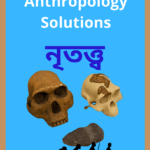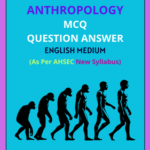Class 11 Anthropology Chapter 3 Cultural Anthropology, HS 1st year Anthropology notes, Anthropology Class 11 Question Answer to each chapter is provided in the list so that you can easily browse throughout different chapters SCERT Class 11 Anthropology Chapter 3 Cultural Anthropology and select needs one.
Class 11 Anthropology Chapter 3 Cultural Anthropology
Also, you can read the AHSEC book online in these sections Solutions by Expert Teachers as per AHSEC (CBSE) Book guidelines. NCERT Solution of Class 11 Anthropology Chapter 3 Cultural Anthropology is part of AHSEC All Subject Solutions. Here we have given AHSEC Class 11 Anthropology Chapter 3 Cultural Anthropology Notes for All Subjects, You can practice these here.
Cultural Anthropology
Chapter – 3
ANTHROPOLOGY
Very short type questions
1. Define culture.
Answer: The ideas, customs, and social behaviour of a particular people or society is called culture.
2. Write E.B. Tylor’s definition of culture.
Answer: E.B. Tylor’s definition of culture – “Culture or civilization is that complex whole which includes knowledge, belief, art, morals, law, customs and any other capabilities and habits acquired by man as a member of society.”
3. Write briefly the anthropological concept of culture.
Answer: The anthropological concept of culture- the English word ‘culture’ has been used in various concepts. In common literature it means social charm and intellectual excellence. Some sociologists have regarded cultured people as leaders of society. In the words of Sorokin and Mac Iver, culture stands for moral, spiritual and intellectual attainments of man.
‘Sanskriti’ is the sanskrit term for culture. Both sanskrit and ‘sanskriti’ have been derived from ‘sanskar’ meaning ritual performances as a result of which he is accepted into various roles in course of his or her life. Thus the meaning of culture is the fulfilment of aims of social life through various sanskars. It is a process of both integration and refinement. Man as a social being attains sociality by performing sanskar.
In general, culture refers to the humanly created patterns of thinking, feeling and behaving that are passed from generation to generation among members of a society. It represents man’s basic needs. It is the behaviour that man has learned as a member of society. Culture consists of all the shared products of human society, both material and non- material.
4. What is material culture?
Answer: Materials culture refers to the tangible aspects of culture, those things that can be touched or seen. Manufactured objects such as tools, weapons, means of communication, clothes, utensils, houses and so forth are manifestations of material culture. By material culture of Assamese agricultural society we mean plough and yoke, harrow, spade, sickle, knife, basketry, etc.
5. What are the differences between material and non-material culture?
Answer: The differences between material and non-material culture are:-
Materials culture refers to the tangible aspects of culture, those things that can be touched or seen. Manufactured objects such as tools, weapons, means of communication, clothes, utensils, houses and so forth are manifestations of material culture. By material culture of Assamese agricultural society we mean plough and yoke, harrow, spade, sickle, knife, basketry, etc. On the other hand, the skill to use tools, weapons, methods of wearing clothes, making if houses, etc. are the non- material aspects of culture. Non-material is called the spiritual or social culture. It consists of the abstract aspects of culture which cannot be directly touched or seen. We cannot touch or see that the earth is not flat. Belief is intangible. Thus non-material culture included the abstract creations of man such as social values and norms, traditions, literature, arts, laws, religious ideas and practices etc. non-material culture is learned and acquired as a member of society and is transmitted from one generation to the other.
6. What is Igloo?
Answer: Igloo is a type of dome-shaped shelter built from blocks of solid snow, traditionally used by Invits.
7. What is environment?
Answer: Environment is the sum total of water, air and lands, inter-relationship among themselves and also with the human beings, other living organisms and property.
8. “Environment influences directly in some aspects of culture and in some aspects it influences indirectly”. Discuss.
Answer: Environmental means conditions which influence the growth and development of organisms. It commonly means surroundings. In this way, ‘environment is the sum total of water, air and land, inter-relationship among themselves and also with the human beings, other living organisms and property.’ This important definition given in Environment Act,1986 clearly states that environment includes all the physical and biological surroundings and their interactions. The close interaction between the organisms and the environment is important in order to satisfy the basic necessities of life. Thus everything influencing the life processes of an organism constitutes its environment.
Man is a social animal possessing culture. Without society, it is impossible to have fullest expression of his personality. He requires society both for his life and for the sake of good life. As a member of society man learns his culture. Hence, what a man does following the prescribed norm of the society is culture. Culture is the socially standardised ways of thinking, feeling and acting that a person acquires as a member of society.
An individual is born in the stream of culture and must continually swim in it if he is to live as a member of society. He leads his entire life in it. Thus culture determines our life-ways.

Hi, I’m Dev Kirtonia, Founder & CEO of Dev Library. A website that provides all SCERT, NCERT 3 to 12, and BA, B.com, B.Sc, and Computer Science with Post Graduate Notes & Suggestions, Novel, eBooks, Biography, Quotes, Study Materials, and more.







